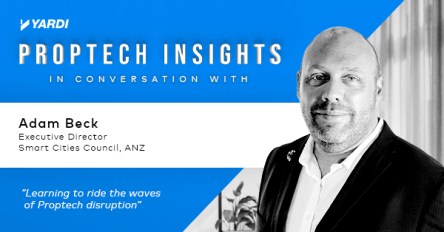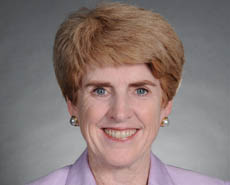Electric vehicles are heading towards real estate at speed and scale. With up to 300 million EVs on the roads by 2030, new business models are beginning to emerge. But for all the opportunities, there are also plenty of obstacles. Yardi’s Bernie Devine and ESR’s Dr. Michael De Jong-Douglas recently sat down to explore the possibilities. Dr. De Jong-Douglas, ESR’s Group Head of Customer Solutions & Partnerships, was the special guest on Yardi’s Proptech Insights, hosted by Bernie Devine, Senior Regional Director at Yardi. The International Energy Agency predicts that the number of electric vehicles on the roads – cars, vans, trucks, and buses – could reach 300 million by 2030. Last year electric car sales took off, surpassing the 6.6 million mark despite supply chain bottlenecks and the ongoing challenges of Covid-19. This took the total number of electric cars on the road to 16.5 million. The passenger vehicle market may be driving towards electrification at a rapid rate, but logistics vehicles – especially trucks travelling longer distances – are an entirely different proposition, the pair noted. But many of the world’s largest logistics companies have made commitments to electrify their fleets. Dr. De Jong-Douglas pointed to several 2030 commitments – DHL’s 60% global EV target, DB Schenker’s “emissions free” European footprint, Amazon’s plan for 10,000 EV vans in Europe and Unilever’s switch to EVs to cut their greenhouse gas emissions by 40-50% among them. Meanwhile, nascent, regional logistics players across Asia Pacific have begun EV initiatives in various markets. These include Linfox, Coupang, Sagawa, Maersk, and JD.com. As Dr. De Jong-Douglas suggested, these illustrate “very real examples of companies in our own backyard doing pilot projects and making very strong public commitments to switch to EVs.” While the market is on the move, there are clear challenges ahead. For example, the issue of range anxiety is easier to overcome in denser urban environments than in geographically dispersed economies like Australia, Devine noted. The uptake of EVs also varies across the region depending on the combination of “carrots” – incentives and subsidies – and “sticks” of regulation. For real estate companies, a “chicken-and-egg” scenario has emerged. How do they decide when, and to what extent, to provide EV charging facilities in their sites, for both passenger cars and delivery trucks? The challenge for asset owners is to roll out charging technology for customers today without getting “caught in one model” that compromises the opportunities tomorrow, Dr. De Jong-Douglas noted. Certainly, the “interconnectivity” of energy efficient buildings, renewable energy and EV charging were emerging as a “combined package” for any customer focused on ESG and “circular” solutions. But are fast, reliable charging stations the best solution? Or, Devine asked, could battery swaps become a thing? Are there other technologies ahead on the horizon? Conveniently located charging stations that allow vehicles to ‘top up’ their charge many times throughout the day make sense for smaller delivery vehicles, the pair agreed. Shell has already begun reimagining its fuelling stations as “energy hubs” with the provision of coffee, snacks and communal areas to provide pleasant places for customers to relax while their EVs recharge. ESR is in conversations with its customers “every single day.”, Dr. De Jong-Douglas added, “and our customers are saying to us: We are doing pilot projects, so get ready.” Check out the latest episode of Yardi’s Proptech Insights series or register for our next...
4 Big Questions
For proptech leaders in 2022
What are the biggest, boldest questions that everyone in real estate needs to answer? Last year, guests on Yardi’s Proptech Insights program shared their secrets to navigating the complex proptech ecosystem. Bernie Devine, Yardi’s Senior Regional Director, asked a lot of questions – and our guests offered many insightful answers. But to kick off 2022, Bernie and guest Adam Beck turned the tables by posing four provocative questions for the region’s property leaders to ponder over the year ahead. It’s a unique idea. But Devine and smart cities champion Adam Beck are unique thinkers. Beck, an urbanist who has championed smart and sustainable cities for more than 25 years, was most recently the Executive Director of the Smart Cities Council for Australia and New Zealand. He was also the architect of the Green Building Council of Australia’s Green Star Communities rating tool and has just launched a new platform, Urbanism.Live, which explores the edges of digital, data and urbanism. The edge of digital, data and urbanism are exciting. But Yardi’s latest research report, developed in partnership with the Property Council of Australia, found around half of Australia’s property companies are still reliant on spreadsheets to assess the performance of their portfolios. What is the barrier stopping these companies from moving beyond Excel? “Tech and data are not the challenge or the barrier. It is the people behind the tech and data,” Beck told Devine. Some quarters of the property industry are stubbornly resistant to change, but Beck – “the eternal optimist” – said big obstacles have been overcome before. Take the built environment’s response to sustainability. “It was considered too costly, too risky.” Fast forward 20 years, and markets now place a premium on green buildings. But this time, we don’t have 20 years,...
Value Opportunity
For British Shopping Centres
Editor’s note: the following article originally appeared in the British real estate publication Property Week on Nov. 25. Martin Betts is Yardi’s Sales Director for UK and Ireland. Are some shopping centre landlords guilty of thinking their asset is simply a property? They get the tenants in, the leases agreed and the rents start rolling in. But thinking in this way can limit the potential of the asset. For unlike an office block or an industrial unit, the shopping centre presents many different avenues for turning revenue. The unique nature of the mall means there is huge potential for additional revenue generation- something landlords and shopping centre managers need to ensure are managed and promoted effectively. Spaces like the walls are potential advertising spots, mobile phone masts can be erected on top of the buildings, pop-up stands can be used to utilise what would otherwise be dead space within the mall and even car washing facilities in the car park – all of this generates rent for the landlord and maximises space. Some of the best shopping centre operators have been doing this for years, but there are still way too many that aren’t or are not capturing the data that highlights where these opportunities exist. The UK market is moving more and more to a turnover rental structure, so an even greater prevalence is put on the landlord to drive footfall and entice people to the centre. But this is not easy in such a competitive retail and shopping centre sector, where you may have three shopping centres in close proximity to one another, all vying for the same customers. People will generally choose on the calibre of the shops and the experience they receive. So how do successful landlords and managers attract...
Global Economy
Interview with Tom Flexner
Paul Fiorilla, Yardi Matrix’s Associate Director of Research, recently sat down with Tom Flexner, Citigroup’s Global Head of Real Estate, to discuss the global economy, the state of the commercial real estate market and new regulations that are impacting the sector. The interview was published in CRE Finance World, which is published by the Washington, DC-based trade group CRE Finance Council. Fiorilla serves as volunteer Editor in Chief of the magazine. Some highlights are below, and the entire interview can be accessed here. Flexner on the economy: It just feels to me that we’re in the midst of adjusting to some sort of overarching longer-term secular change marked by continued tepid growth, low interest rates, low oil prices, forced deleveraging by foreign sovereigns and so on … So we have a whole bunch of things working against us, and frankly it’s hard to identify a single reason to be terribly optimistic about the world’s growth trajectory. Other than somehow it always seems to work out at the end. But, you know, up until the financial crisis we had a global economy supported by huge credit expansion — consumers, governments, companies. It lifted growth beyond what would have happened had credit not expanded at such a vigorous pace. Today, we still have a significant amount of leverage, particularly at the sovereign level, but also in the banking systems in China, Japan and Europe; plus regulatory initiatives which will serve to constrain credit creation going forward. And this kind of countervailing pressure — deleveraging — will possibly hinder growth, as credit creation will not be the tailwind it once was. And so I think the twin impacts of globalization and technology are showing they also have downsides. Technological advances used to amplify human muscle or human...
Robert Teel
Yardi Leadership Series
Many commercial property managers seek to abbreviate the leasing process, expedite reporting, and improve overall efficiency and accuracy. Unfortunately, it is a struggle to compile and interpret data from multiple software programs within their organizations. Robert Teel, Senior VP G&A at Yardi, and his team are redefining the way that user groups interact through software. As a former financial accounting systems consultant, Teel is familiar with the challenges that property managers and analysts face when their software is not fully integrated: long process lifecycles and crippling inefficiencies. “With a single stack, you can shorten nearly every business process lifecycle. In essence, our vision is that our clients can create an ecoysytem on the single stack to connect their front office with back office, and even extend participation to external users,” says Teel. Deloitte Consulting LLP reports that single stack solutions are the new standard for cloud, digital, and analytics. Projects can experience gains through “faster environment readiness, the ability to engineer advanced scalability, and the elimination of power/connectivity constraints.” A single stack solution can remove limitations and promote intelligent growth. Teel observes that self-contained ecosystems allow users to minimize redundancies, capitalize upon a more efficient use of resources, and create consistent and accurate processes that add value to users. For example, Yardi client Prologis (a $20B US REIT with over 4,000 properties) has reduced their quarterly property reforecasting process by months. “We went from a six-month quarterly forecast process to an eight-week process, and our accuracy is vastly improved,” according to Arthur Nelson, Vice President of Global Business Systems, Prologis. Such results are possible due to the single stack’s ability to track a process from start to finish, offering automated operations and consistent reporting. Teel offers the leasing process as an example, “The prospect—a...
John Pendergast
Yardi Leadership Series
John Pendergast first learned the importance of persistence and attention to detail as a musician. The avid guitarist plays music from a wide range of genres, honing in on the nuance within each piece. “There is a great attention to detail in playing music and different instruments,” explains Pendergast, Senior Vice President, CSD at Yardi. “There is so much detail in how to intonate and emphasize particular notes in a sequence with the right timing. You have to practice often to get it right, but you always keep learning.” “Both of those things are very relevant at Yardi. The need to do things over and over again until you get good at them is a key piece. There is also great importance in exercising attention to detail and making sure that we do the right things for our clients. ” As the needs of clients change, Yardi software and services develop accordingly. Pendergast and his team take the time to understand the details of the user experience. The team then creates and supports software that makes the user experience practical and seamless. Transaction processing through Yardi is one such example. The expectations of today’s renters and tenants are vastly different than just a few years ago, triggering a focus on online and mobile payments. To meet these demands, Yardi created a robust suite of payment processing options for clients: Yardi Online Payments™, Walk-in Payment System (WIPS®), Yardi CHECKscan™, and RentCafe® TextPay™ integrate with Yardi Voyager® and Genesis 2 to streamline rent collection, cut operational costs, and reduce processing errors. Residents can conveniently pay rent online, via text, or at participating retailers. Clients can also quickly bulk scan and digitize rent payments made with checks and money orders. Services are available for residential and commercial clients. Pendergast says:...
Big Data
Understanding your customers
Companies strive to better understand their customers and stay a step ahead of their competitors. Various methods of accomplishing these goals have come and gone over the years but none has stirred as much buzz as Big Data. Through such analytics, companies now have the power to explore human-generated data in addition to transactions, market trends, and interactions with customers. In the past, the real estate market operated through a rearview mirror. Forecasts were cloudy, based on month-old figures at best. Today, Big Data allows residential and commercial firms to step forward with trends as they happen, making predictions based on real time information. No longer relying on quarter-end results, firms reap the benefits of daily and weekly data on inventory levels, price fluctuation, asking rates and lease rates, and beyond. Analysts can focus these figures on one property, one neighborhood, the entire city or on a national and global level. Big Data has become the most sought-after tool for harvesting, interpreting, and implementing vast quantities of information with adjustable levels of precision. The applications for Big Data seem endless, with common best use cases varying by industry. Big Data could help commercial and residential real estate firms to: predict risks to investments earlier and more accurately, such as depreciation rates or changes in demand adjust construction and operation costs based on the most recent sales and cost data, resulting in fewer setbacks and surprises during project completion create event- and behavior-based targeting analyze daily and weekly sales figures for competitive pricing and profit optimization increase cyber security for a safer online leasing experience for renters monitor energy consumption on properties, identifying areas of resource inefficiency evaluating proposed business strategies and suggesting measurable goals Of all the data harvested, users are gaining the most...
Ken Doble
Quantitive Realty Capital
With more than two decades of experience in the residential property management industry, Ken Doble, Partner at Atlanta-based Quantitive Realty Capital (QRC), is well-versed in what’s trending in multifamily today. A technology-savvy executive who shares updates via his Twitter feed daily, Doble began his career 20 years ago as the on-site property manager of a 24 unit apartment community of Atlanta apartments. He’s also a military veteran, and served as a paratrooper in Panama and the Gulf War. We asked for his insight on current happenings in multifamily in the Southeast and Mid-Atlantic, where QRC is in the process of acquiring more properties, including distressed assets that need improvements. Most of their current 12 properties are comprised of class B and C apartments. There’s strong bidding competition among investors for class A inventory in the southeast, Doble noted, especially in top markets like Atlanta. QRC has focused on opportunities in the secondary markets and properties that need rehabilitation. In 2011, the company spent $7 million on renovations. Improving those properties is Doble’s favorite part of the work he does today. “I like seeing the transformation of the property. We typically go in and buy distressed properties that have deferred maintenance. I like to go in and do the renovations on those properties and see the properties come up from a low occupancy, say in the 60s, to the 95-96 range. I like to see the properties really stabilize, see the happy residents, and see the properties and staff really take off and perform.” At the Parkview Apartments in metro Atlanta, where 18 units were down and there were crime, aesthetic and mold issues on site, QRC achieved a complete turnaround in just a number of months. With large numbers of families in residence at...
Lucy Billingsley
Billingsley Co.
Lucy Billingsley’s distinguished career in real estate development ranks her among the nation’s leading female industry executives. In the fourth decade of her career, she maintains great passion for the next project to command her attention. “My favorite deal is always the next one,” she told us during a recent interview. Billingsley Company, the Dallas-based company with land, office space, industrial, retail, single-family, multi-family, mixed-use and master-planned developments that she and her husband Henry founded in 1978, is flourishing. New phases of 10,000 unit master-planned rental communities The Neighborhoods of Austin Ranch and Cypress Waters are currently underway, and Billingsley is excited about changing the face of the multifamily experience. The company is also expanding its office and industrial holdings. Billingsley also devotes much of her time and energy to charitable work, and her philanthropy has included The Chiapas Project, Grameen Foundation USA, Women for Women International, National Geographic Society Council of Advisors, World Affairs Council (Dallas), Brain and Creativity Institute at USC, Council of Foreign Relations, The Hockaday School, and The Hunter and Stephanie Hunt Institute for Engineering and Humanity Advisory Board. In a short conversation, she filled us in on few views of the current marketplace, how she chooses philanthropic causes, and the lessons that her father, famed developer Trammel Crow, imparted to her. TBS: It’s been a challenging climate for real estate sales, investment and development over the last several years, although Texas come through the down economy very strongly. What do you see as the most pivotal focal points for property executives as the financial climate nationally continues to improve? LB: I think the multifamily world is a world that has made a significant and permanent shift in its role in America today – the shift is because the American...









